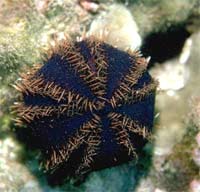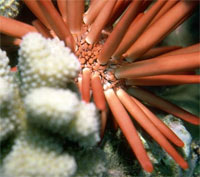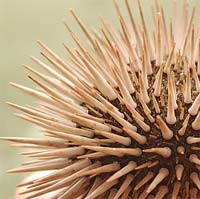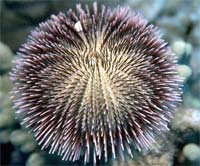|

 Size: Typical sea urchins have spines 1-2 cm (approximately 1/2 to 1 in.) in length (e.g. "Sea urchin", right), a millimeter or two thick, and not terribly sharp. Diadema antillarum, familiar in the Caribbean, has thin spines that can be 10-20 cm long (4-8 in.). Common colors include black and dull shades of green, olive, brown, purple, and red. Size: Typical sea urchins have spines 1-2 cm (approximately 1/2 to 1 in.) in length (e.g. "Sea urchin", right), a millimeter or two thick, and not terribly sharp. Diadema antillarum, familiar in the Caribbean, has thin spines that can be 10-20 cm long (4-8 in.). Common colors include black and dull shades of green, olive, brown, purple, and red.
Echinoderms: Sea urchins are echinoderms (phylum Echinodermata), which also includes starfish, sea cucumbers, Brittle-stars, and crinoids. Like other echinoderms they have five-fold symmetry (called pentamerism) and move by means of hundreds of tiny, transparent, adhesive "tube feet". The pentamerous symmetry is not obvious at a casual glance, but is easily seen in the dried shell of the urchin.

Movement: At first glance a sea urchin often appears to be an inanimate object, or one which is incapable of moving. Sometimes the most visible sign of life is the spines, which are attached at their bases to ball-and-socket joints and can be pointed in any direction. In most urchins, a light touch elicits a prompt and visible reaction from the spines, which converge toward the point that has been touched. A sea urchin has no visible eyes, legs or means of propulsion, but it can move freely over surfaces by means of its adhesive tube feet, working in conjunction with its spines.
Jaw: On the oral surface of the sea urchin is a centrally located jaw. It is surrounded by five horny teeth. The entire chewing organ is known as Aristotle's lantern. The name comes from Aristotle's accurate description in his History of Animals:
...the urchin has what we may call its head and mouth down below, and a place for the issue of the residuum up above. The urchin has, also, five hollow teeth inside, and in the middle of these teeth a fleshy substance serving the office of a tongue. Next to this comes the oesophagus, and then the stomach, divided into five parts, and filled with excretion, all the five parts uniting at the anal vent, where the shell is perforated for an outlet... In reality the mouth-apparatus of the urchin is continuous from one end to the other, but to outward appearance it is not so, but looks like a horn lantern with the panes of horn left out.
 Spines: The spines, which in some species are long and sharp, serve to protect the urchin from predators. The spines can inflict a painful wound on a human who steps on one, but they are not seriously dangerous and it is not clear that the spines are truly venomous (unlike the pedicellariae between the spines, which are). Spines: The spines, which in some species are long and sharp, serve to protect the urchin from predators. The spines can inflict a painful wound on a human who steps on one, but they are not seriously dangerous and it is not clear that the spines are truly venomous (unlike the pedicellariae between the spines, which are).
Feeding: Sea urchins feed mainly on algae. Sea urchin is one of the favorite foods of sea otters. Recently the population of sea otters in the Monterey Bay of California has diminished. As a result, the population of sea urchins has multiplied and they are chewing up the kelp forest in the area and upsetting the ecosystem. Left unchecked, urchins will devastate their environment, creating what biologists call an urchin barren, devoid of macroalgae and associated fauna.
Shells: The bare shells ("tests") of sea urchins are sometimes found on beaches, and are often sold in seaside souvenir shops. Dropping a sea urchin into ordinary household bleach quickly removes the spines and flesh substance, leaving a clean test. The test has a dramatic geometrical beauty and looks utterly unlike the familiar molluscan seashells.
 Special place in biology: The sea urchin occupies a special place in biology due to its long-time use as a standard subject for studies in embryology. The sea urchin, particularly Arbacia punctulata, is the source of textbook descriptions of "the" egg, "the" embryo, and their early development. Theodor Boveri studied two species of sea urchin and concluded that all chromosomes were needed for normal embryonic development. At the Marine Biological Laboratory at Woods Hole, the Arbacia egg achieved almost the status of a standard "living cell" for physiological, biochemical and cytological work—resulting, of course, in overfishing and, in 1945, the near-extinction of the local Arbacia population. Sea urchins are a favored organism for studies of development using a systems biology approach, often in conjunction with gene knockdown studies using Morpholino antisense oligos. Special place in biology: The sea urchin occupies a special place in biology due to its long-time use as a standard subject for studies in embryology. The sea urchin, particularly Arbacia punctulata, is the source of textbook descriptions of "the" egg, "the" embryo, and their early development. Theodor Boveri studied two species of sea urchin and concluded that all chromosomes were needed for normal embryonic development. At the Marine Biological Laboratory at Woods Hole, the Arbacia egg achieved almost the status of a standard "living cell" for physiological, biochemical and cytological work—resulting, of course, in overfishing and, in 1945, the near-extinction of the local Arbacia population. Sea urchins are a favored organism for studies of development using a systems biology approach, often in conjunction with gene knockdown studies using Morpholino antisense oligos.
 Symmetry: Since the sea urchin is globular and radially symmetrical, and since like other organisms its early embryological stages are globular and radially symmetrical, it is surprising that its larval stage, known as a pluteus, is not. The pluteus exhibits only bilateral symmetry. (Pluteus is Latin for "easel," to which the larvae of some species really do show a close resemblance). During development, the sea urchin must transform first itself from having radial to bilateral symmetry, and then again from having bilateral to radial symmetry. Symmetry: Since the sea urchin is globular and radially symmetrical, and since like other organisms its early embryological stages are globular and radially symmetrical, it is surprising that its larval stage, known as a pluteus, is not. The pluteus exhibits only bilateral symmetry. (Pluteus is Latin for "easel," to which the larvae of some species really do show a close resemblance). During development, the sea urchin must transform first itself from having radial to bilateral symmetry, and then again from having bilateral to radial symmetry.
Invisible larva: A group of pluteus larvae viewed under a dissecting microscope between crossed polarizers is a dramatic sight. The entire larva, including the calcareous skeleton, is transparent. However, the skeleton is birefringent. The result is that only the skeleton becomes visible--in glowing rainbow colors which change as the swimming larva changes its orientation with respect to the polarizers.

Within the echinoderms, sea urchins are classified as echinoids (class Echinoidea). Specifically, the term "sea urchin" refers to the "regular echinoids," which are symmetrical and globular. The ordinary phrase "sea urchin" actually includes several different taxonomic groups: the Echinoida and the Cidaroida or "slate-pencil urchins", which have very thick, blunt spines (see image at right), and others . Besides sea urchins, the Echinoidea also includes three groups of "irregular" echinoids: flattened sand dollars, sea biscuits, and heart urchins.
All text is available under the terms
of the GNU Free Documentation License
|